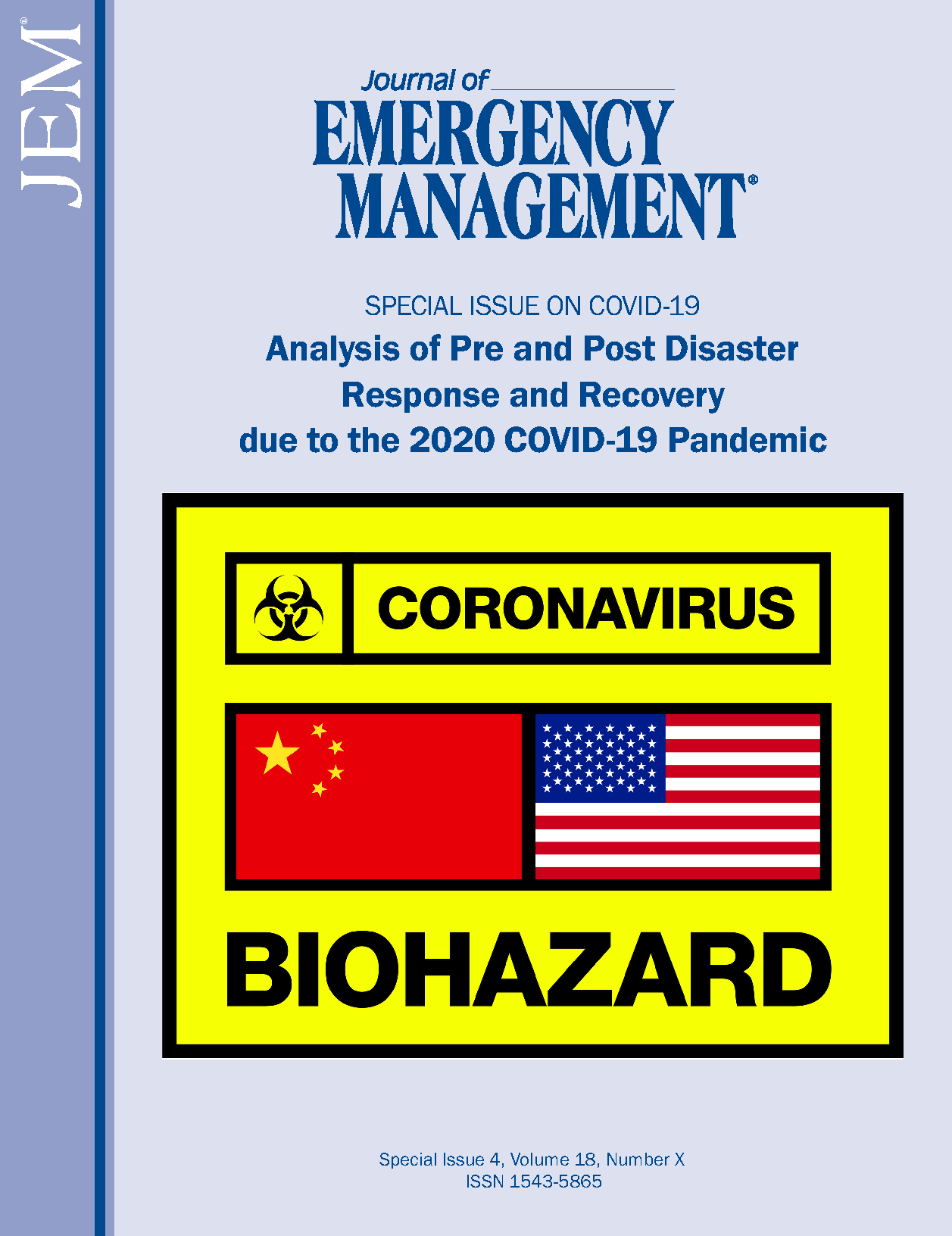Assessing fear of COVID-19 at an academic medical center
DOI:
https://doi.org/10.5055/jem.0532Keywords:
COVID-19, academic medical center, fear, assessing fear of COVID-19, surveyAbstract
Purpose: This study measured the degree of COVID-19-related fear among academic medical center employees, identified subsections with high COVID-19 fear, and validated the Fear of COVID-19 Scale with medical professionals in the United States.
Methods: This study is a cross-sectional, inter-net-based survey delivered by Qualtrics. The survey was conducted at the Oklahoma University Health Sciences Center between May 21 and June 18, 2020. The medical center is composed of seven health-care colleges, child and adult hospitals, a Veterans Hospital, and outpatient services clinics across the Oklahoma City area. Faculty, staff, and students (N = 1,761) from the Oklahoma University Health Sciences Center completed the survey.
Results: COVID-19 fear is highest among non-clinical employees, smokers, and those with pre-existing conditions. Males and females, both clinicians and non-clinicians, appear to express their COVID-19 fears differently. Employees worried most about their families contracting the virus. The Fear of COVID-19 Scale is a valid and reliable assessment instrument among US healthcare workers. Responses were compared based on pre-existing medical condition(s), patient care or nonpatient care, sex, and occupational specialization. Analyses reveal a strong Cronbach’s α measure of internal consistency (α = 0.87). Significant differences were observed among employees with a nonclinical emphasis (p = 0.02), with a predisposing medical health condition (p < 0.001), and with a nonacademic occupational specialization (p < 0.01), and by sex (p < 0.001).
Conclusions and discussion: COVID-19 fear significantly impacts academic medical center employ-ees. Medical centers should address both healthcare and nonhealthcare workers’ COVID-19-related fears. It is important to recognize that men and women may have different types of fears and express them differently, necessitating a gender-specific approach to man-aging COVID-19 fears. Employees with pre-existing conditions or who have vulnerable family members require additional support to remain fully functional and on the job.
References
Center for Systems Science and Engineering (CSSE): COVID-19 dashboard [Online]. John Hopkins University Medicine. Available at https://coronavirus.jhu.edu/map.html. Accessed September 20, 2020.
Lamber L: Another 1.48 million people filed for unemployment even as states begin to reopen. Fortune. June 25, 2020. Available at https://fortune.com/2020/06/25/us-unemployment-rate-numbers-claims-this-week-total-job-losses-june-20-2020-benefits-claims/. Accessed September 20, 2020.
Yan H: Protests erupt again over coronavirus shelter-in-place orders. Here’s why some governors aren’t budging. CNN U.S. April 20, 2020. Available at https://www.cnn.com/2020/04/20/us/protests-coronavirus-stay-at-home-orders/index.html. Accessed September 20, 2020.
Musu C: War metaphors used for COVID-19 are compelling but also dangerous. The Conversation. April 8, 2020. Available at https://theconversation.com/war-metaphors-used-for-covid-19-are-compelling-but-also-dangerous-135406. Accessed September 20, 2020.
Rodeck D: Alphabet soup: Understanding the shape of a COVID- 19 recession. Forbes. July 20, 2020. Available at https://www.forbes.com/advisor/investing/covid-19-coronavirus-recession-shape/. Accessed January 5, 2021.
Lee SA: Coronavirus Anxiety Scale: A brief mental health screener for COVID-19 related anxiety. Death Stud. 2020; 44(7): 393-401. DOI:10.1080/07481187.2020.1748481.
Xiang Y, Yang Y, Li W, et al.: Timely mental health care for the 2019 novel coronavirus outbreak is urgently needed. Lancet Psychiatry. 2020; 7(3): 228-229. DOI:10.1016/s2215-0366(20)30046-8.
Liu TB, Chen XY, Miao GD, et al.: Recommendations on diagnostic criteria and prevention of SARS-related mental disorders. J Clin Psychol Med. 2003; 13: 188-191.
Stein MB: Coronavirus disease 2019 (COVID-19): Psychiatric illness. UpToDate. July 14, 2020. Available at https://www.uptodate.com/contents/coronavirus-disease-2019-covid-19-psychiatric-illness. Accessed September 20, 2020.
Balaratnasingam S, Janca A: Mass hysteria revisited. Curr Opin Psychiatry. 2006; 19(2): 171-174. DOI:10.1097/01. yco.0000214343.59872.7a.
Lai J, Ma S, Wang Y, et al.: Factors associated with mental health outcomes among health care workers exposed to coronavirus disease 2019. JAMA Netw Open. 2020: 3(3): e203976. DOI:10.1001/jamanetworkopen.2020.3976.
Zhang W, Wang K, Yin L, et al.: Mental health and psychosocial problems of medical health workers during the COVID-19 epidemic in China. Psychother Psychosom. 2020: 89(4): 242-250. DOI: 10.1159/00050763.
Colenda CC, Applegate WB, Reifler BV, et al.: COVID-19: Financial stress test for academic medical centers. Acad Med. 2020; 95(8): 1143-1145. DOI:10.1097/acm.0000000000003418.
JAMA Network Learning: Coronavirus (COVID-19) mitigation: Preparing hospitals and health systems [JN CME Film]. Available at https://edhub.ama-assn.org/jn-learning/video-player/18327108. Accessed September 20, 2020.
Burrer SL, de Perio MA, Hughes MM, et al.: Characteristics of health care personnel with COVID-19—United States, February 12-April 9, 2020. MMWR Morb Mortal Wkly Rep. 2020; 69(15): 477- 481. DOI:10.15585/mmwr.mm6915e6.
Ahorsu DK, Lin C, Imani V, et al.: The Fear of COVID-19 Scale: Development and initial validation. Int J Ment Health Addict. DOI:10.1007/s11469-020-00270-8.
Reznik A, Gritsenko V, Konstantinov V, et al.: COVID-19 fear in eastern Europe: Validation of the Fear of COVID-19 Scale. Int J Ment Health Addict. DOI:10.1007/s11469-020-00283-3.
National Institutes of Health Diversity in Extramural Programs: Underrepresented racial and ethnic groups. Washington, DC. 2020. Available at https://extramural-diversity.nih.gov/diversity-matters/underrepresented-groups#:~:text=The%20National%20Science%20Foundation%20reports,sciences%20on%20a%20national%20basis. Accessed September 20, 2020.
Lu W, Wang H, Lin Y, et al.: Psychological status of medical workforce during the COVID-19 pandemic: A cross-sectional study. Psychiatry Res. 2020; 288: 112936. DOI:10.1016/j.psy-chres.2020.112936.
Pappa S, Ntella V, Giannakas T, et al.: Prevalence of depression, anxiety, and insomnia among healthcare workers during the COVID-19 pandemic: A systematic review and meta-analysis. Brain Behav Immun. 2020; 88: 901-907. DOI:10.1016/j.bbi.2020.05.026.
Ruiz MA, Gibson CA: Emotional impact of the COVID-19 pandemic on U.S. health care workers: A gathering storm. Psychol Trauma. 2020; 12(1): S153-S155. DOI:10.1037/tra000085.
Elbay RY, Kurtulmus¸ A, Arpacıoğlu S, et al.: Depression, anxiety, stress levels of physicians and associated factors in Covid-19 pandemics. Psychiatry Res. 2020; 290: 113130. DOI:10.1016/j.psy-chres.2020.113130.
Published
How to Cite
Issue
Section
License
Copyright 2007-2025, Weston Medical Publishing, LLC and Journal of Emergency Management. All Rights Reserved.






